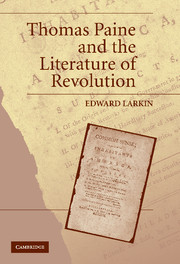Book contents
- Frontmatter
- Contents
- Acknowledgments
- Introduction
- 1 Inventing an American Public: The Pennsylvania Magazine and Revolutionary American Political Discourse
- 2 “Could the Wolf Bleat Like the Lamb”: Paine's Critique of the Early American Public Sphere
- 3 Writing Revolutionary History
- 4 The Science of Revolution: Technological Metaphors and Scientific Methodology in Rights of Man and The Age of Reason
- 5 “Strong Friends and Violent Enemies”: The Historical Construction of Thomas Paine through the Nineteenth Century
- Epilogue: Paine and Nineteenth-Century American Literary History
- Works Cited
- Index
5 - “Strong Friends and Violent Enemies”: The Historical Construction of Thomas Paine through the Nineteenth Century
Published online by Cambridge University Press: 25 July 2009
- Frontmatter
- Contents
- Acknowledgments
- Introduction
- 1 Inventing an American Public: The Pennsylvania Magazine and Revolutionary American Political Discourse
- 2 “Could the Wolf Bleat Like the Lamb”: Paine's Critique of the Early American Public Sphere
- 3 Writing Revolutionary History
- 4 The Science of Revolution: Technological Metaphors and Scientific Methodology in Rights of Man and The Age of Reason
- 5 “Strong Friends and Violent Enemies”: The Historical Construction of Thomas Paine through the Nineteenth Century
- Epilogue: Paine and Nineteenth-Century American Literary History
- Works Cited
- Index
Summary
Perhaps no Revolutionary American patriot figure has been as persistently maligned, misrepresented, and misunderstood as Tom Paine. The lack of reliable information on his life, combined with the controversial nature of his work, has made Paine's life story an open field for speculation on the part of admirers and detractors alike. A quick glance at the most recent biography of Paine, John Keane's Tom Paine, A Political Life, reveals that we still know very little about the first thirty seven years of his life, before he arrived in Philadelphia late in 1774. Even after he became renowned for his role in the American Revolution, Paine remained an elusive character in both his public and private lives. This is not to say that there was a scarcity of images of Paine in the contemporary press, but rather that because of the profound impact he had on people, those images were generally exaggerated, and often contradictory. In this chapter I will not attempt to cast further light on the details of Paine's life; instead, I wish to explore what we might call his life in print: how his identity and ideas were constructed and appropriated by others from the publication of the first biography, authored by George Chalmers in 1791, to the first attempt at a comprehensive and nonpartisan biography in 1891.
- Type
- Chapter
- Information
- Thomas Paine and the Literature of Revolution , pp. 149 - 178Publisher: Cambridge University PressPrint publication year: 2005



